US Cross-Border Road Freight Transport Market Size
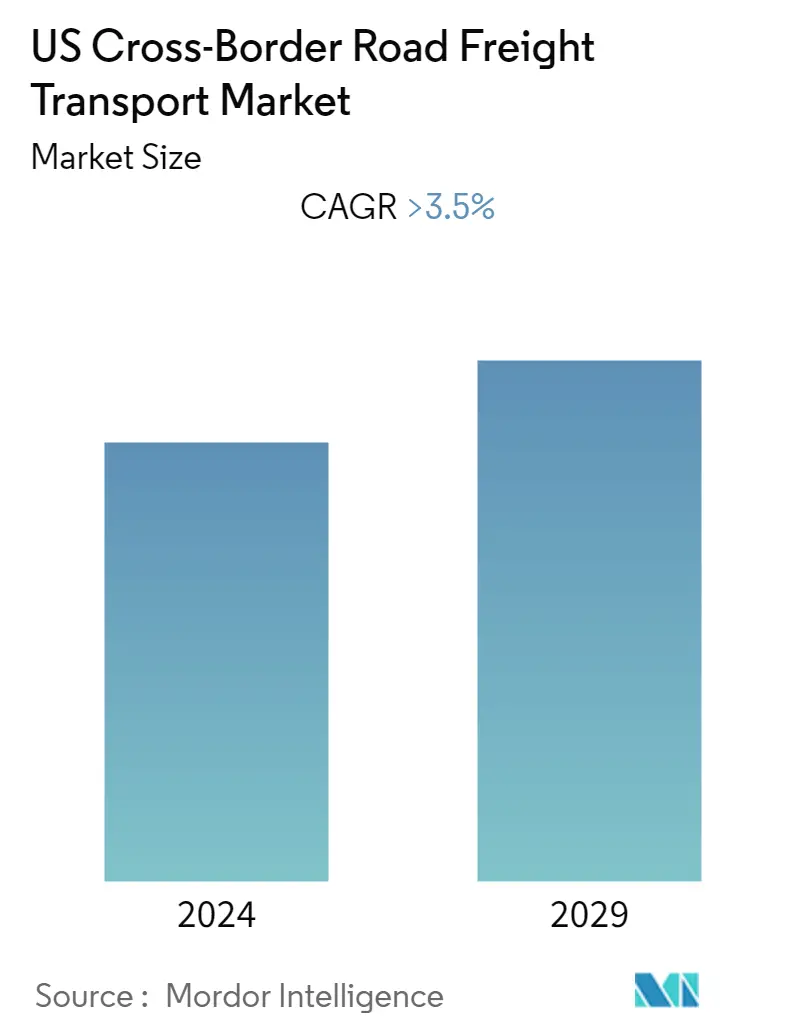
| Study Period | 2020 - 2029 |
| Base Year For Estimation | 2023 |
| Forecast Data Period | 2024 - 2029 |
| Historical Data Period | 2020 - 2022 |
| CAGR | 3.50 % |
| Market Concentration | Medium |
Major Players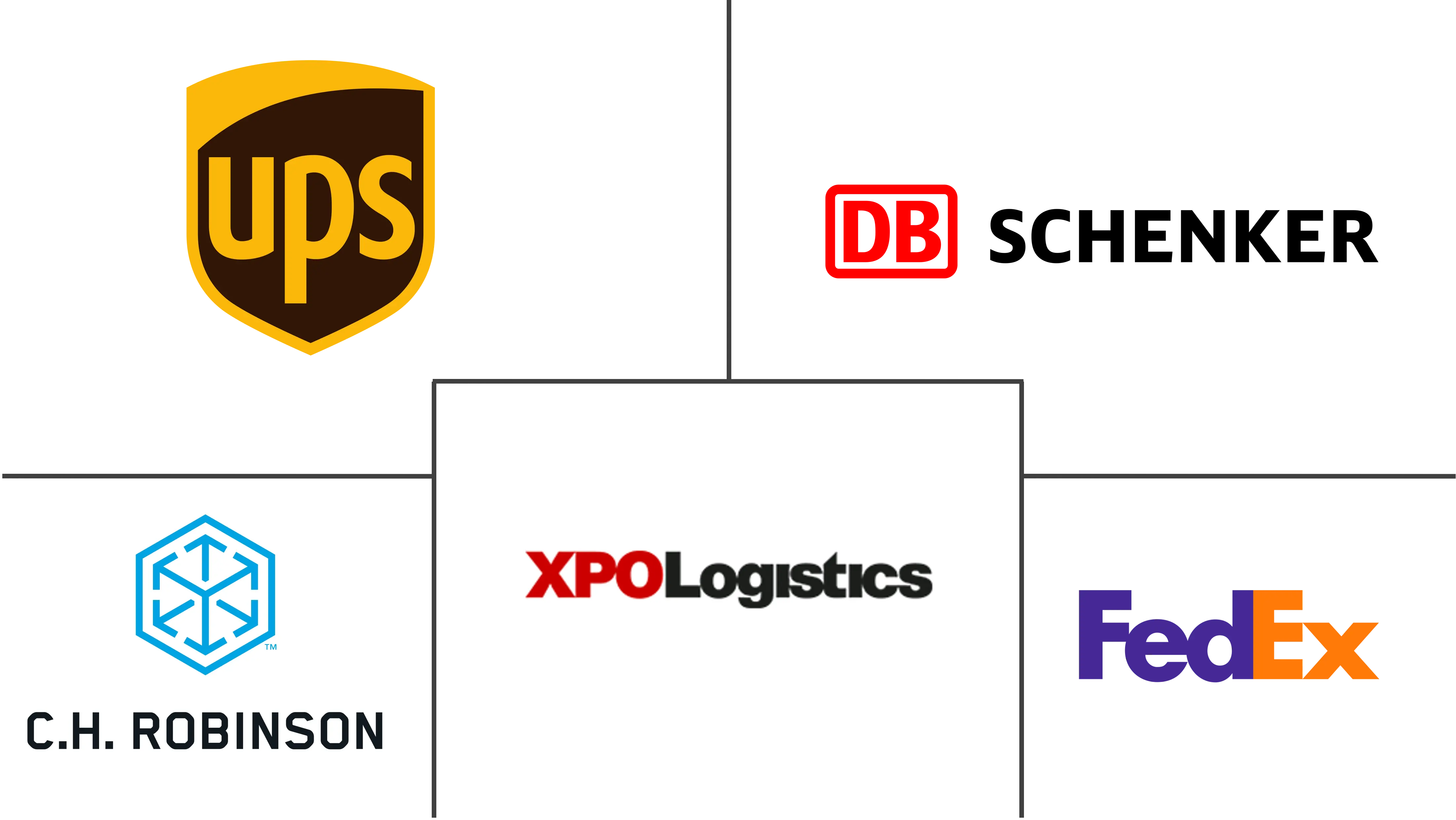
*Disclaimer: Major Players sorted in no particular order |
US Cross-Border Road Freight Transport Market Analysis
The size of the United States cross-border road freight transport market is USD 1.02 billion in the current year and is anticipated to register a CAGR of over 3.5% during the forecast period.
- Public-health measures to control the COVID-19 pandemic reduced economic activity. US GDP declined by 1.2% in the first quarter of 2020, and unemployment rose to 14.7%. With no clear timeline for the lockdown and other restrictions to end, freight companies were responding to the immediate crisis by preserving cash, creating safe workspaces, adjusting the size of the workforce to meet the demand, and providing humanitarian aid. During the crisis, demand has been volatile, spiking or plummeting by mode and customer profile.
- The United States' cross-border road freight transport market is driven by the growing technological advancement in the trucking industry and the trade agreements among the North American countries, while road congestions and high emissions drag down the market growth. Canada and Mexico are major trading partners of the US and these are the most important countries when it comes to cross-border freight transport from the US.
- U.S. relations with Mexico are strong and vital, and Mexico remains one of the United States' closest and most valued partners. The countries share a 2,000-mile border with 47 active land ports of entry. Trade between Mexico and the United States reached the historical figure of USD 779.3 billion in 2022, a growth of 17% compared to the amount registered in 2021, according to the United States Census Bureau.
- This figure was supported by an annual growth of 18.3% in merchandise imports from Mexico, which totaled USD 454.9 billion. The amount represented 14% of the total imports that the United States made in 2022. Exports from the United States to Mexico increased 17.3% compared to 2021, to register an amount of USD 324.3 billion. With this value of total trade, Mexico remained the second largest trading partner of the United States, only surpassed by Canada, which totaled USD 793.8 billion.
- The United States and Canada share the world's longest international border, 5,525 miles with 120 land ports of entry, and their bilateral relationship is one of the closest and most extensive. Nearly USD 2.6 billion a day in goods and services trade crosses between them every day. The deficit with Canada increased USD 31.6 billion to USD 81.6 billion in 2022. Exports increased USD 48.4 billion to USD 356.1 billion and imports increased USD 79.9 billion to USD 437.7 billion.
- In March 2022, the total transborder freight of US was USD 141.9 billion, moved by all modes of transportation, up 23.8% compared to March 2021. Freight between the U.S. and Canada totaled USD 72.9 billion. Freight between the U.S. and Mexico totaled USD 69.0 billion. Trucks moved USD 85.5 billion of freight, up 15.7% compared to March 2021.
US Cross-Border Road Freight Transport Market Trends
This section covers the major market trends shaping the US Cross-Border Road Freight Transport Market according to our research experts:
Free Trade Agreements (FTAs) Facilitating the Growth of the Market
The U.S. has 14 FTAs with 20 countries which comprise about 40 percent of U.S. goods' exports. U.S. Free Trade Agreement (FTA) partner countries provide greater market access through reduced or eliminated tariffs, intellectual property protection, and elimination of non-tariff barriers among other provisions. The United States has FTAs with Australia, Bahrain, Chile, Colombia, Israel, Oman, Panama, Canada, Mexico, etc. The Agreement between the United States of America, the United Mexican States, and Canada (USMCA) is a free trade agreement between Canada, Mexico, and the United States. It replaced the North American Free Trade Agreement (NAFTA) implemented in 1994 and is sometimes characterized as "NAFTA 2.0", or "New NAFTA' since it largely maintains or updates the provisions of its predecessor. USMCA created one of the world's largest free trade zones, spanning roughly 500 million people and totaling over USD 26 trillion in GDP (PPP). Canada and Mexico remain the top trading partners to the United States with China not far behind.
From NAFTA's entry into force in 1994 to 2020, the year NAFTA was replaced by the USMCA, U.S. trade of goods with Mexico and Canada increased from USD 343.1 billion to USD 1 trillion, despite some setbacks. Since the USMCA entered into force on July 1, 2020, trade has been consistent with that set by NAFTA. In 2021, trade flows in North America reached USD 1.3 trillion, and in 2022 was at the same pace. From January to May 2022, trade in the region reached USD 642.6 billion, which compared with the same period in 2021 (i.e., USD 521.8 billion) representing a 23.15% increase. Canada and the U.S. share a land border close to 9,000 km long, which is the longest border in the world. The two countries cooperate closely to manage the secure and efficient flow of goods and people across the border which is vital to both countries' economic competitiveness and prosperity. Canada and the U.S. share one of the largest trading relationships in the world. The US exported over USD 366.11 billion worth of goods to Canada in 2022 up 19% from USD 307.75 billion in 2021. Thus, the presence of FTAs like USMCA will continue to facilitate the trade between US and its neighbouring countries, supporting the market growth.
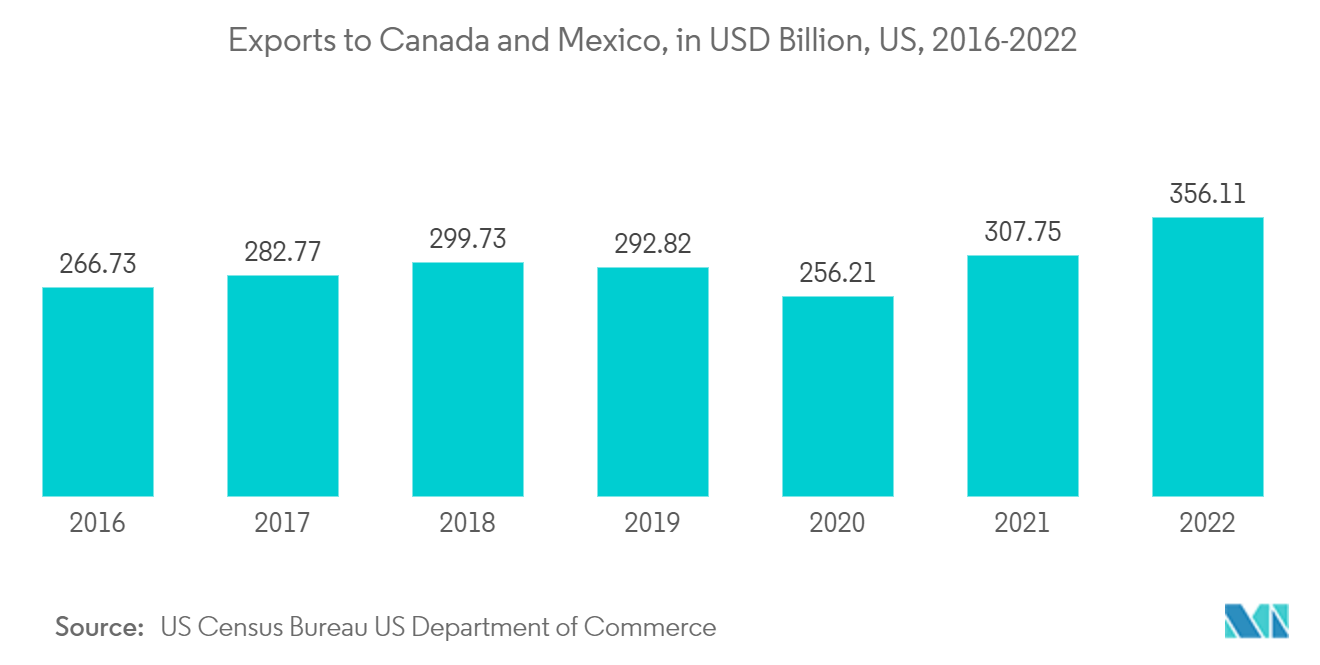
Driver Shortages May Create Challenge for the Market
The American Trucking Association (ATA) reported a shortage of 80,000 drivers in 2021, an all-time high that could reach 160,000 by 2030. The high average age of drivers, leading to significant numbers of retirements; the industry's failure to recruit more women, who make up just 8% of drivers, compared to 47% of the overall workforce; lifestyle disadvantages of long-haul trucking; inability to pass drug tests; and inadequate truck parking are among the primary contributors of the shortage. The truck driver shortage eased slightly in 2022, after more than 90% of carriers raised pay in 2021. Raising driver pay has somewhat helped in adding drivers. Truckload fleets doled out an average raise of 10.9%, according to the 2022 ATA Driver's Compensation Study. But the industry still faces its second-largest number of vacancies on record. The improvement is expected to be temporary, given that an aging workforce and freight demand are both projected to grow. The shortage projection is expected to grow over the next decade.
Despite the shrinking number of overall driver vacancies, carriers again ranked driver shortage and driver retention as their top concerns in trucking, according to the American Transportation Research Institute's 2022 Critical Issues in the Trucking Industry report. Carriers in neighboring countries are struggling with similar challenges in recruiting and retaining drivers. Canada, whose trucking industry is a fraction of the size of the U.S., allows 18-year-olds to haul freight. But the country is still confronting a shortage of 20,000 drivers that is projected to grow to 55,000 by 2024. Mexico's truck fleets face a similar challenge. The country was short 54,000 drivers in 2021. The supply chain is majorly affected by the shortage of drivers in the trucking industry. This results in a lack of goods, delays, and higher costs. Thus, these driver shortages in the US and its neighboring countries may create challenges for the market. According to ATA, the industry must recruit nearly 1.2 million drivers over the next 10 years to replace drivers leaving voluntarily or involuntarily and avoid the driver shortage ballooning to more than 160,000 in 2030.
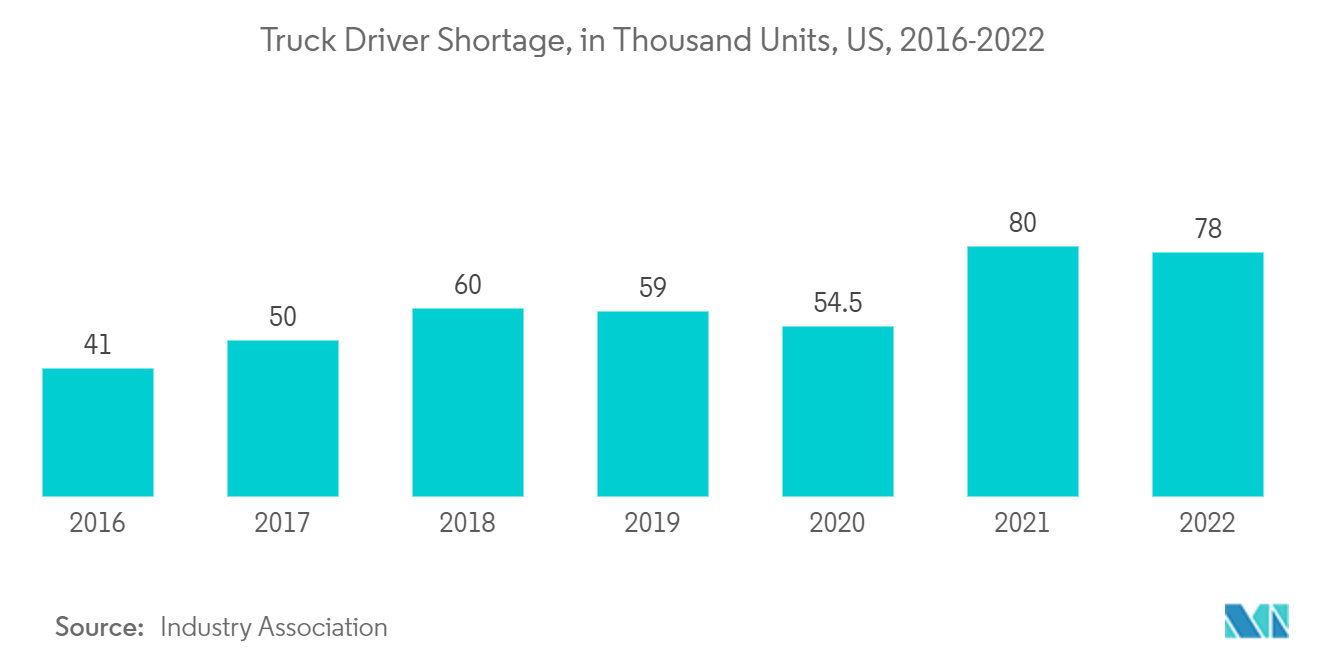
US Cross-Border Road Freight Transport Industry Overview
The United States cross-border road freight transport market is fragmented in nature, with various domestic and international companies actively involved in the market. Companies like UPS, DB Schenker, FedEx, C.H. Robinson, and XPO Logistics are some of the major players in the market. The trucking industry in the region is facing intense competition in terms of technological improvements. The driver shortage is one of the main problems faced by the industry. The market is observing an increasing number of players expanding their services to gain a competitive advantage. Companies are also focusing on mergers and acquisitions in order to expand their reach and increase their operational efficiencies.
US Cross-Border Road Freight Transport Market Leaders
-
United Parcel Service (UPS)
-
DB Schenker
-
FedEx
-
C.H.Robinson
-
XPO Logistics Inc.
*Disclaimer: Major Players sorted in no particular order
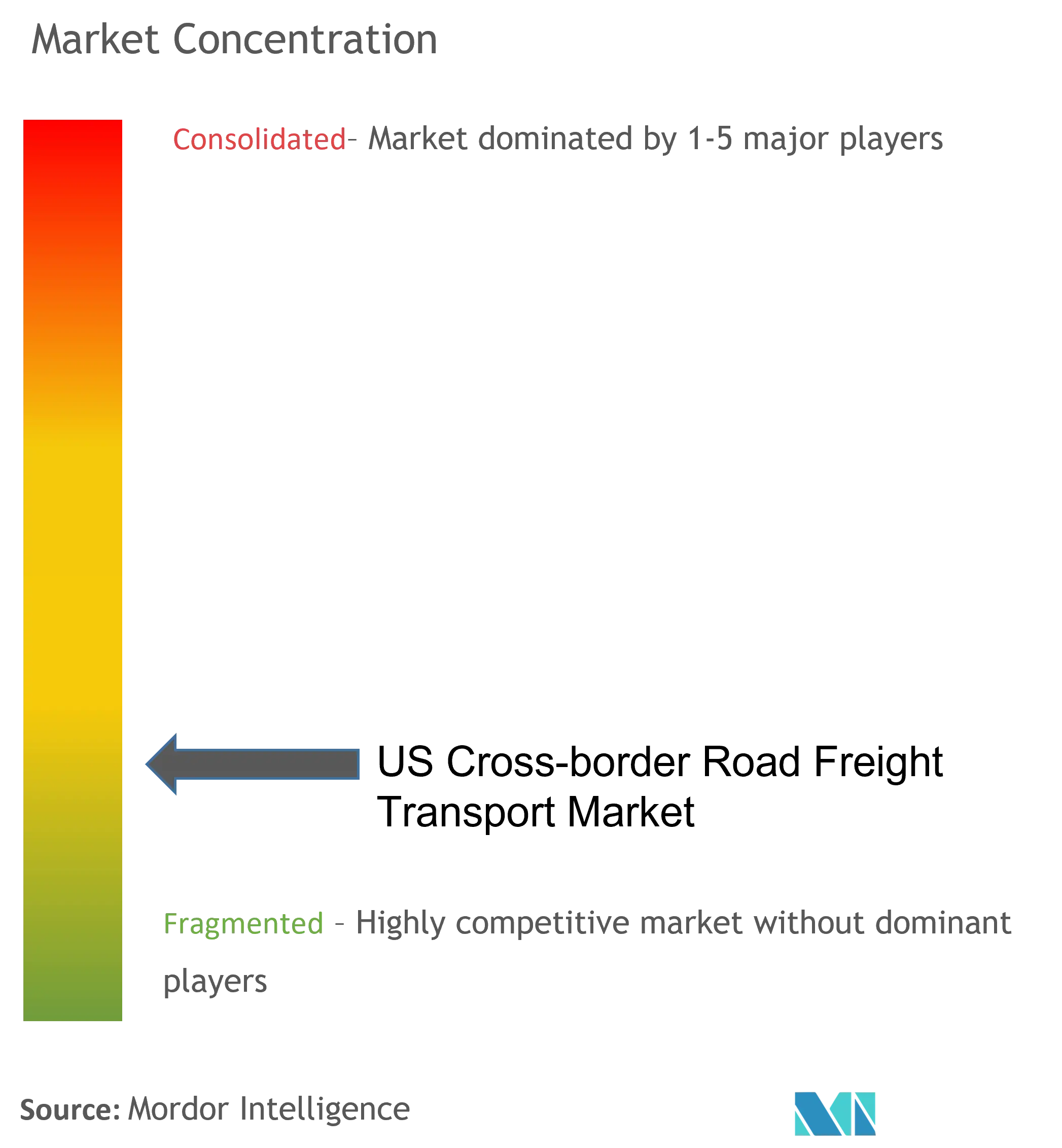
US Cross-Border Road Freight Transport Market News
- October 2022: KAG Logistics completed the acquisition of Toronto-based cross-border freight transportation company Connectrans Logistics. Connectrans has an established carrier network between the U.S. and Canada with expertise in transportation solutions within dry van, temperature control, flatbed, over-dimensional, and intermodal. The acquisition of Connectrans expands KAG Logistics's footprint in the Canadian logistics market. The acquisition will also give Connectrans customers more access to the U.S. marketplace, specialized assets, technologies, and additional logistics expertise.
- September 2022: DB Schenker, one of the world's leading logistics service providers, announced the completion of its previously announced acquisition of USA Truck, a leading capacity solutions provider, for USD 435 million. USA Truck will operate within the network of DB Schenker. USA Truck's approximately 1,900-unit fleet of trucks, 2,100 employees, partnerships with more than 36,000 active contract carriers, a strategic network of terminals across the Eastern half of the United States, and a nationwide third-party logistics presence will immediately provide capacity solutions to meet the evolving demands of both regional and national DB Schenker customers.
US Cross-Border Road Freight Transport Market Report - Table of Contents
1. INTRODUCTION
- 1.1 Study Assumptions and Market Definition
- 1.2 Scope of the Study
2. RESEARCH METHODOLOGY
- 2.1 Analysis Methodology
- 2.2 Research Phases
3. EXECUTIVE SUMMARY
4. MARKET INSIGHTS
- 4.1 Market Overview
- 4.2 Technological Trends (Autonomous Trucks, Electric and Alternative Fueled Vehicles, etc.)
- 4.3 Government Regulations and Initiatives
- 4.4 Brief on Key Transport Corridors
- 4.5 Insights on Customs Clearance Procedures at Border Exit Points
- 4.6 Review and Commentary on Driver Shortage and Fuel Costs
- 4.7 Insights on Prices of Freight Transport Expenditures
- 4.8 Insights on Sales of Different Types of Trucks and Used Trucks, and Truck Manufacturers in the United States
- 4.9 Qualitative and Quantitative Insights on Domestic Trucking in the United States
- 4.10 Overview - Cross-border Refrigerated Trucking and Key Commodity Groups Transported
- 4.11 Review and Commentary on the US Border States (Infrastructure, Inland Ports, Trade Lanes, etc.)
- 4.12 Impact of COVID-19 on the Market
5. MARKET DYNAMICS
- 5.1 Market Drivers
- 5.2 Market Restraints
- 5.3 Market Opportunities
- 5.4 Industry Value Chain Analysis
-
5.5 Industry Atrractiveness - Porter's Five Forces Analysis
- 5.5.1 Bargaining Power of Buyers/Consumers
- 5.5.2 Bargaining Power of Suppliers
- 5.5.3 Threat of New Entrants
- 5.5.4 Threat of Substitute Products
- 5.5.5 Intensity of Competitive Rivalry
6. MARKET SEGMENTATION
-
6.1 By Service
- 6.1.1 Full Truck Load (FTL)
- 6.1.2 Less-than Truckload (LTL)
- 6.1.3 Courier, Express, and Parcel (CEP)
-
6.2 By End-user
- 6.2.1 Manufacturing and Automotive
- 6.2.2 Oil and Gas, Mining, and Quarrying
- 6.2.3 Agriculture, Fishing, and Forestry
- 6.2.4 Construction
- 6.2.5 Distributive Trade (Wholesale and Retail Segments - FMCG included)
- 6.2.6 Other End Users (Telecommunications and Pharmaceuticals)
7. COMPETITIVE LANDSCAPE
- 7.1 Market Concentration Overview
-
7.2 Company Profiles
- 7.2.1 United Parcel Service (UPS)
- 7.2.2 DB Schenker
- 7.2.3 FedEx
- 7.2.4 C.H.Robinson
- 7.2.5 XPO Logistics Inc.
- 7.2.6 Swift Transportation Company
- 7.2.7 Schneider National
- 7.2.8 J.B.Hunt Transport Services Inc.
- 7.2.9 US Xpress
- 7.2.10 Landstar System Inc.
- 7.2.11 YRC Worldwide Inc.
- 7.2.12 Polaris Transportation Group
- 7.2.13 Moto Transportation
- 7.2.14 Hitachi Transport System*
- *List Not Exhaustive
8. FUTURE OF THE MARKET
9. APPENDIX
- 9.1 Economic Statistics - Transport and Storage Sector's Contribution to the Economy
- 9.2 United States Transport Statistics, by Mode (Focus on Share of Trucking of All Modes)
- 9.3 Historic Data - Road Freight Statistics
- 9.4 Key Cross-border Freight Data, by Canadian Provinces and Mexican States
US Cross-Border Road Freight Transport Industry Segmentation
Cross-border road freight transport means the transport of freight in the course of an industry, trade, or business, to or from the Republic, crossing or intending to cross its borders into the territory of another state.
The United States Cross-border Road Freight Transport Market is segmented by Service (Full Truck Load, Less-than-Truckload, and Courier, Express, Parcel), and by End-user (Manufacturing and Automotive, Oil and Gas, Mining, and Quarrying, Agriculture, Fishing and Forestry, Construction, Distributive Trade, Healthcare and Pharmaceutical, and Other End Users). The report offers market sizes and forecasts for all the above segments in value (USD billion).
| By Service | Full Truck Load (FTL) |
| Less-than Truckload (LTL) | |
| Courier, Express, and Parcel (CEP) | |
| By End-user | Manufacturing and Automotive |
| Oil and Gas, Mining, and Quarrying | |
| Agriculture, Fishing, and Forestry | |
| Construction | |
| Distributive Trade (Wholesale and Retail Segments - FMCG included) | |
| Other End Users (Telecommunications and Pharmaceuticals) |
US Cross-Border Road Freight Transport Market Research FAQs
What is the current US Cross-Border Road Freight Transport Market size?
The US Cross-Border Road Freight Transport Market is projected to register a CAGR of greater than 3.5% during the forecast period (2024-2029)
Who are the key players in US Cross-Border Road Freight Transport Market?
United Parcel Service (UPS), DB Schenker, FedEx, C.H.Robinson and XPO Logistics Inc. are the major companies operating in the US Cross-Border Road Freight Transport Market.
What years does this US Cross-Border Road Freight Transport Market cover?
The report covers the US Cross-Border Road Freight Transport Market historical market size for years: 2020, 2021, 2022 and 2023. The report also forecasts the US Cross-Border Road Freight Transport Market size for years: 2024, 2025, 2026, 2027, 2028 and 2029.
US Cross-Border Road Freight Transport Industry Report
Statistics for the 2024 US Cross-Border Road Freight Transport market share, size and revenue growth rate, created by Mordor Intelligence™ Industry Reports. US Cross-Border Road Freight Transport analysis includes a market forecast outlook to 2029 and historical overview. Get a sample of this industry analysis as a free report PDF download.



